Mercedes-Benz GLC : Safely transporting children in the vehicle / Installing a LATCH-type (ISOFIX) child restraint system on the rear seat
Installing a LATCH-type (ISOFIX) child restraint system on the rear seat
WARNING Risk of accident if the rear bench seat, rear seat and seat backrest are not engaged
The rear bench seat, rear seat and seat backrest may fold forwards, even when you are driving.
- As a result, the vehicle occupant will be pushed into the seat belt with increased force. The seat belt will not be able to protect as intended and could cause additional injury.
- Objects or loads in the trunk or cargo compartment will not be restrained by the seat backrest.
 Make sure that the rear bench seat, the
rear seat and the seat backrest are
engaged before every trip.
Make sure that the rear bench seat, the
rear seat and the seat backrest are
engaged before every trip.
If the left and right seat backrests are not engaged and locked in place, this will be shown on the multifunction display on the instrument cluster.
If the center seat backrest is not engaged and locked in place, the red lock verification indicator will be visible.
WARNING Risk of injury or death if the permissible gross mass of the child and child restraint system together is exceeded.
Too much load may be placed on the LATCHtype (ISOFIX) child restraint system and the child may not be restrained correctly in the event of an accident, for example.
 If the child and the child restraint system
together weigh more than the permissible
gross mass of 73 lb (33 kg ),
only use a LATCH-type (ISOFIX) child
restraint system with which the child is
secured with the vehicle seat belt.
If the child and the child restraint system
together weigh more than the permissible
gross mass of 73 lb (33 kg ),
only use a LATCH-type (ISOFIX) child
restraint system with which the child is
secured with the vehicle seat belt.
 Also secure the child restraint system
with the Top Tether belt, if available.
Also secure the child restraint system
with the Top Tether belt, if available.
Always comply with the information about the mass of the child restraint system:
- in the manufacturer's installation and operating instructions for the child restraint system used
- on a label on the child restraint system, if present
Regularly check that the permissible gross mass of the child and child restraint system is still complied with.
When installing a child restraint system, observe the following:
 Always observe the correct use of the seats and consider their suitability for attaching a child restraint system.
Always observe the correct use of the seats and consider their suitability for attaching a child restraint system.
 Always comply with the manufacturer's installation and operating instructions for the child restraint system used.
Always comply with the manufacturer's installation and operating instructions for the child restraint system used.
 Make sure that the child's feet do not touch the front seat. If necessary, move the front seat slightly forwards.
Make sure that the child's feet do not touch the front seat. If necessary, move the front seat slightly forwards.
 When installing a LATCH-type (ISOFIX)
child restraint system, also observe the following:
When installing a LATCH-type (ISOFIX)
child restraint system, also observe the following:
 When using a baby car seat in weight group 0/0+ and a rearward-facing child restraint system in weight group I on a rear seat: adjust the front seat so that the seat does not touch the child restraint system.
When using a baby car seat in weight group 0/0+ and a rearward-facing child restraint system in weight group I on a rear seat: adjust the front seat so that the seat does not touch the child restraint system.
 When using a forward-facing child restraint system in weight group I: the backrest of the child restraint system must lie as flat as possible against the backrest of the vehicle seat.
When using a forward-facing child restraint system in weight group I: the backrest of the child restraint system must lie as flat as possible against the backrest of the vehicle seat.
 If the head restraint of the child seat cannot be fully extended when it is installed in the vehicle, this will result in restrictions on the maximum size setting for child restraint systems in weight category II or III.
If the head restraint of the child seat cannot be fully extended when it is installed in the vehicle, this will result in restrictions on the maximum size setting for child restraint systems in weight category II or III.
Contact with the roof when the head restraint is fully extended and locked in place will not result in any restrictions on use.
 The child restraint system must not be put under strain between the roof and the seat cushion and/or be installed facing the wrong direction. Where possible, adjust the seat cushion inclination accordingly.
The child restraint system must not be put under strain between the roof and the seat cushion and/or be installed facing the wrong direction. Where possible, adjust the seat cushion inclination accordingly.
 The child restraint system must not be put under strain by the head restraint. Adjust the head restraints as appropriate.
The child restraint system must not be put under strain by the head restraint. Adjust the head restraints as appropriate.

 LATCH-type (ISOFIX) mounting bracket
LATCH-type (ISOFIX) mounting bracket
Before every journey, make sure that the LATCHtype (ISOFIX) child restraint system is engaged correctly in both mounting brackets in the vehicle.
NOTE Damage to the seat belt for the center seat during installation of the child restraint system
 Make sure that the seat belt is not trapped.
Make sure that the seat belt is not trapped.
 Attach the LATCH-type (ISOFIX) child
restraint system to both mounting brackets
in the vehicle.
Attach the LATCH-type (ISOFIX) child
restraint system to both mounting brackets
in the vehicle.
 Activating or deactivating the special seat belt retractor
Activating or deactivating the special seat belt retractor
WARNING Risk of injury or death if a
seat belt is unfastened while the vehicle
is in motion
If the seat belt is released while the vehicle is
in motion, the child safety lock is deactivated
and the child restraint system is no longer
correctly secured...
 Securing Top Tether
Securing Top Tether
WARNING Risk of injury or death if the
rear seat backrests are not locked after
Top Tether belts are installed
The rear seat backrests may fold forwards
when you are driving...
Other information:
Mercedes-Benz GLC 2016-2025 Owners Manual: Removing and installing the wheel trim/hub caps
Requirements: The vehicle is prepared for a wheel change. Plastic hub cap To remove: turn the center cover of the hub cap counter-clockwise and remove the hub cap. To install: make sure that the center cover of the hub cap is turned counter-clockwise...
Mercedes-Benz GLC 2016-2025 Owners Manual: Switching the seat ventilation on/off
Requirements: The power supply is switched on. Press button repeatedly until the desired blower setting has been reached. Depending on the blower setting, up to three indicator lamps will light up. If all indicator lamps are off, the seat ventilation is switched off...


 To activate: press button
To activate: press button
 for approximately one second.
for approximately one second.